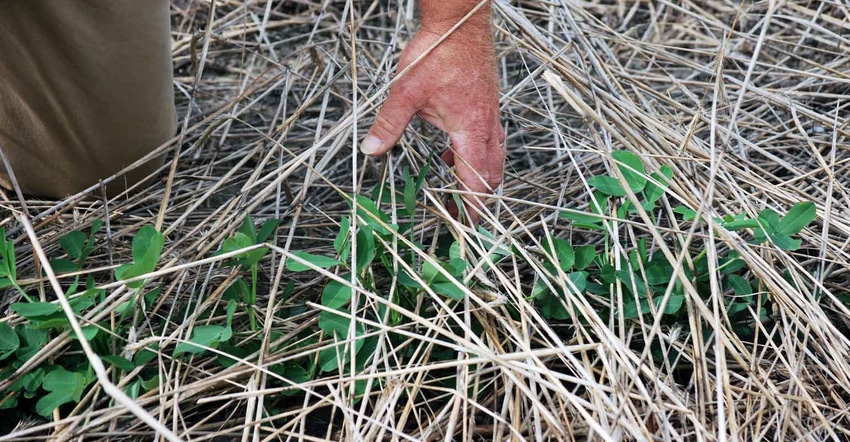May 13, 2022

When I left Washington 21 months ago to return to academia, I rediscovered how farmers, foresters and ranchers see their lands not only as the nation’s source of food and fiber, but as some of the best climate-solutions tools we have at our disposal.
We need to leverage that ethic if we as a nation are realistic about achieving emissions reductions goals. It will give us stronger standing to encourage other nations to adopt such goals in Glasgow next month and beyond.
Incentives for agricultural producers to engage in climate-smart practices such as no-till agriculture could turn millions of acres in Florida alone into more powerful carbon sinks. At the same time, it could bolster our national security by ensuring a reliable food supply.
Consumers don’t pay farmers for sequestering carbon or reducing cows’ methane emissions. They just expect to continue enjoying affordable and nutritious food that’s always on supermarket shelves come hurricane, wildfire, drought or pandemic.
Fortunately, there appears to be growing awareness in public policy circles that investing in the potential of farmers as partners for solutions to the climate crisis is much more productive than blaming them for it.
U.S. Secretary of Agriculture Tom Vilsack recently unveiled a climate-smart agriculture initiative to fund pilot projects. I see it as one important way to advance the innovation agenda established by my previous boss, former Secretary of Agriculture Sonny Perdue, aimed at increasing agricultural production by 40% while halving agriculture’s environmental footprint by 2050.
The work, of course, will be done in the states. The well-established partnership between land-grant universities and farmers has long produced the science that has made us the envy of the world in food production, taking us from nearly half our population working in agriculture to less than 2 percent today. In the 1930s, the average farm fed four people. Today, it feeds 166.
Florida farmers didn’t wait for me when I was leading the United States Department of Agriculture’s extramural research arm—or anyone else in D.C.—to prod them toward climate action. Visionary agricultural producers here started in earnest three years ago to discuss and plan how they could do more to deliver climate solutions. With the non-profit Solutions from the Land facilitating and the University of Florida’s Institute of Food and Agricultural Sciences (UF/IFAS) providing technical support, the producer-led Florida Climate Smart Agriculture Work Group is seeking ways to incentivize planet-friendly practices.
The group came to consensus that for an incentive program to succeed, we need to quantify the ecosystems services farms deliver. This inspired UF to start developing an ecosystems monitoring network that it aims to take nationwide, using artificial intelligence-driven approaches to taking data from sensors to quantify ecosystems services.
Farmers are already motivated to take a more active role in climate solutions because of the many impacts of climate change on agriculture. Severe storms, floods, drought and wildfire events damage their operations and impact their livelihoods.
As the state often identified as ground zero for the impacts of climate change, Florida is well positioned to lead this national movement. UF announced a $70 million investment in artificial intelligence last year and has one of the nation’s fastest AI supercomputers in higher education to help drive it.
UF/IFAS, the university’s agricultural branch, which I lead, has faculty in all 67 Florida counties with the close relationships with local farmers to ensure the relevancy and applicability of university innovations.
To advance support for climate-smart agriculture, our farmer leaders, with support from UF/IFAS and Solutions from the Land, organized a kitchen table discussion with U.S. Rep. Kathy Castor of Florida, who leads the House Select Committee on the Climate Crisis. Those leaders have also taken time away from their day jobs producing our food to tell us the story of how they can do more if properly incentivized.
Farmers will have to grow 70 percent more food than they do now to keep up with mid-century population projections. We’ve got to figure out how to protect the planet while doing that.
Consumers are increasingly interested in carbon footprint and food miles. It can drive purchasing based on how food is produced
New methods of food production require research to validate and improve the payoff to plants and planet. They require upfront investments by farmers. Our nation needs an investment in agricultural research and farmer adoption of technologies to maximize agriculture’s potential as a source of climate solutions.
J. Scott Angle is the former director of the United States Department of Agriculture’s National Institute of Food and Agriculture. He is now the University of Florida’s Vice President for Agriculture and Natural Resources and leader of the UF Institute of Food and Agricultural Sciences (UF/IFAS).
Source: University of Florida, which is solely responsible for the information provided and is wholly owned by the source. Informa Business Media and all its subsidiaries are not responsible for any of the content contained in this information asset.
You May Also Like




